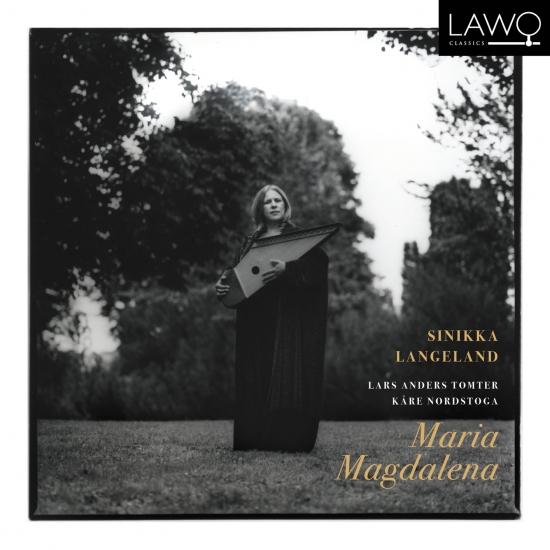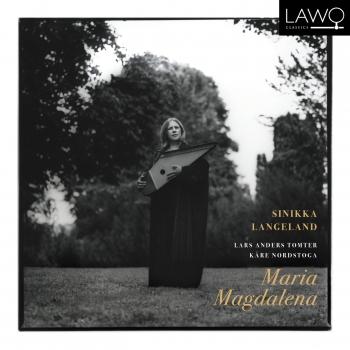
Maria Magdalena Sinikka Langeland, Lars Anders Tomter, Kåre Nordstoga
Album info
Album-Release:
2021
HRA-Release:
08.10.2021
Label: Lawo Classics
Genre: Classical
Subgenre: Vocal
Artist: Sinikka Langeland, Lars Anders Tomter, Kåre Nordstoga
Composer: Johann Sebastian Bach (1685-1750), Sinikka Langeland
Album including Album cover Booklet (PDF)
- Traditional:
- 1LangelandTraditional: Mary went to the source (as sung by Anne Hansdatter Hynne)01:49
- Johann Sebastian Bach (1685 - 1750):
- 2Bach: Fantasia sopra 'Christ lag in Todesbanden', BWV 71805:30
- Traditional:
- 3Traditional: Mary cometh to the sepulchre (as sung by Martin H. Haugsmoen)05:31
- Johann Sebastian Bach:
- 4Bach: Concerto in G Major, BWV 592: I. Allegro03:24
- Traditional:
- 5Traditional: Concerto in G Major, BWV 592: II. Grave / Mary and the angels02:29
- 6Traditional: Noli me tangere / Mary Magdalene sees Jesus (as sung by Ingebjørg Hagen)04:19
- Johann Sebastian Bach:
- 7Bach: Concerto in G Major, BWV 592: III. Presto02:02
- Traditional:
- 8Traditional: Jesus shows himself to the disciples (as sung by Anne Hansdatter Hynne) / Jesus leaves the disciples (as sung by Martin H. Haugsmoen)06:15
- 9Traditional: Cello Suite No. 6 in D Major, BWV 1012: I. Prélude / Mary comforts the disciples (Arr. for Viola and Voice in G Major)04:11
- Johann Sebastian Bach:
- 10Bach: Cello Suite No. 6 in D Major, BWV 1012: II. Allemande (Arr. for Viola in G Major)07:57
- Traditional:
- 11Traditional: Peter and Mary (as sung by Ola Johannesen Kolden)00:57
- Johann Sebastian Bach:
- 12Bach: Cello Suite No. 6, BWV 1012: III. Courante (Arr. for Viola in G Major)03:13
- Traditional:
- 13Traditional: Tell us the things that you remember (as sung by Ola Johannesen Kolden)00:56
- Johann Sebastian Bach:
- 14Bach: Cello Suite No. 6 in D Major, BWV 1012: IV. Sarabande (Arr. for Viola in G Major)04:01
- Sinikka Langeland (b. 1961):
- 15Langeland: Mary’s vision02:15
- Johann Sebastian Bach:
- 16Bach: Cello Suite No. 6 in D Major, BWV 1012: V. Gavotte I / VI. Gavotte II (Arr. for Viola in G Major)03:39
- 17Bach: Cello Suite No. 6 in D Major, BWV 1012: VII. Gigue (Arr. for Viola in G Major)03:54
- Sinikka Langeland:
- 18Langeland: Peter’s jealousy03:06
- Johann Sebastian Bach:
- 19Bach: Allein Gott in der Höh’ sei Ehr’, BWV 67605:29
Info for Maria Magdalena
The story of Mary Magdalene has been a source of comfort for many women, and research has shown that medieval ballads about Mary Magdalene are often sung by single mothers. Young women who were outcasts must have found some measure of consolation in the songs about Mary, who bore children with her father, her brother and a priest, but was cleansed of sin after doing penance in the wilderness for many years. But the possibility should not be overlooked that the songs could have been sung with a sarcastic undertone, becoming an unassailable and liberating weapon when there was no other recourse for rebelling against unjust treatment. The Mary Magdalene ballads, found in Solr, Telemark and Gudbrandsdalen, along with other folk tunes and improvisations, form the musical basis of the vocal element, where Sinikka Langeland uses the recitative form to tell the story while surrounded by works of Johann Sebastian Bach. The instrumental music is meant to intensify the emotions and atmosphere of the story although it is in itself, of course, some of the most beautiful music ever written. Bach/Vivaldis well-known Concerto in G Major, Christ lag in Todesbanden, BWV 718 and Allein Gott in der Hh sei Ehr, BWV 676 are played by Kre Nordstoga on the famous Wagner organ in the Nidaros Cathedral, and Bachs Cello Suite in D Major, BWV 1012 (here in G Major) is played on the viola by Lars Anders Tomter. Langeland also improvises vocally to two of Bachs works. Between the texts that describe Jesus appearing to his disciples after the resurrection, she plays a 15-string kantele. The recording was made in the Nidaros Cathedral, and represents the continuation of a project of many years standing to place Norwegian religious folk songs side by side with organ chorales by Bach, using the same hymn as a basis. Here Langeland is taking a freer approach, but is still pairing folk songs with works by Bach, as on her earlier recording of songs about the Virgin Mary. Marias song was released by the ECM label in 2009. This new release presents a fascinating and multifaceted portrait of the most prominent woman in the Christian world after the Virgin Mary. SINIKKA LANGELAND SONG/KANTELE Sinikka Langeland was born in Kirkenr, Solr, in 1961, and is one of the most distinctive folk musicians of our time. She has brought the Skogfinn (Forest Finn) culture into focus through her research, reinterpretations and presentations. She plays the kantele, the Finnish national instrument, but is also known as an interpreter of folk songs such as rune songs and kveding (a traditional vocal technique). After having discovered some folk variants of Kyrie and other religious folk songs, she initiated a long-term project of juxtaposing these with organ chorales and other works by Johann Sebastian Bach that are based on the same hymns. This fascinating combination has resulted in five records, and presents an entirely new musical landscape. She sounds like a whole orchestra with her remarkable vocal and kantele technique, one journalist noted.
Sinikka Langeland, vocals
Lars Anders Tomter, viola
Kåre Nordstoga, organ
Please Note: We offer this album in its native sampling rate of 48kHz, 24-bit. The provided 96kHz version was up-sampled and offers no audible value!

Sinikka Langeland
The way I use my voice has been influenced most strongly by Norwegian folk singing. Singing cow calls can actually be as challenging technically as singing an opera aria.”
Sinikka Langeland was born in Kirkenær in southeastern Norway in 1961, and studied piano, guitar and contemporary folksong. In 1981 she discovered the kantele (traditional 39-string dulcimer), which would become her main musical instrument along with the voice. She has said: “My Karelian mother told me about the instrument when I was a child, and one day we went to Finland to find one for me. I had not heard it before I got one. First I played just for fun, but after a while I felt a real sense of bonding with the instrument.” The sound-world conjured up by Langeland’s canteles seems to carry archaic echoes older than ‘folk’ tradition.
After studies in Paris and Olso, she became absorbed in a research project to sift through archives of old songs and music from Finnskogen and expand her “folk” repertoire to include rune songs, incantations, and old melodies from Finland and Karelia, as well as medieval ballads and religious songs. Langeland’s songs often focus on the relationship between people and nature.
She recorded her first solo CD in 1994, and made her ECM debut in 2007 with Starflowers:“There are jewels everywhere on this arresting example of ego-free music-making,” enthused the IrishTimes. She followed this up with Maria’s Song, in the company of two distinguished classical musicians – organist Kare Nordstoga and "giant of the Nordic viola" Lars Anders Tomter – interweaving folk melodies with the timeless strains of J S Bach. The Land that is Not is, like Starflowers, a quintet album, which in this case draws its inspirations from poets Edith Södergran (1892–1923) and Olav Håkonson Hauge (1908–94).
Langeland’s 2015 album,The Half-Finished Heaven, is a suite of songs largely based around “the mystery and joy of everyday encounters with animals in the forest”. John Kelman described it as “an album of touching melancholy, haunting beauty and oftentimes completely unexpected flights of improvisational fancy from a quartet of simpatico players”.
In 2010 Sinikka Langeland received the Rolf Gammleng Prize and in 2012 the Sibelius Prize.













